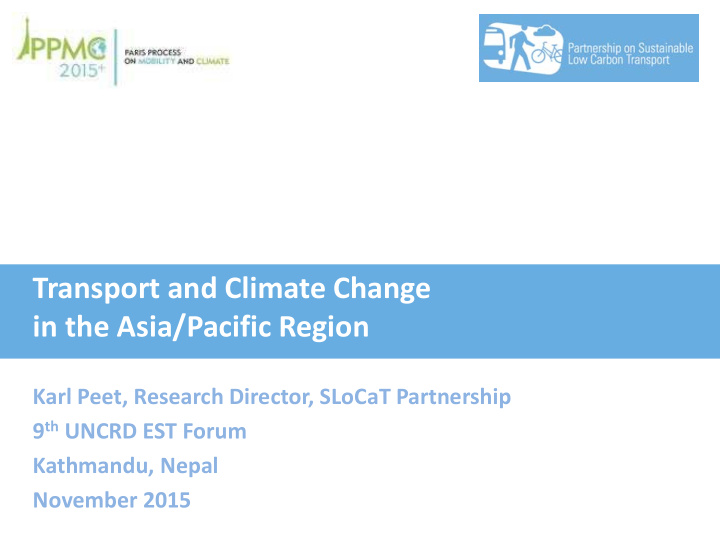



Transport and Climate Change in the Asia/Pacific Region Karl Peet, Research Director, SLoCaT Partnership 9 th UNCRD EST Forum Kathmandu, Nepal November 2015
Transport Emissions Trends in EST Region
Transport Emissions Growth in INDC countries Business as Usual (BAU) 9000 8203 Sub-Saharan Africa 8000 Transport CO2 Emissions (MT) 7000 6482 Middle East & North 6000 Africa 5282 4612 South Asia 5000 3948 4000 East Asia & Pacific 3000 Latin America & 2000 Caribbean 1000 North America 0 1990 2000 2010 2020 2030 Europe & Central Asia Transport CO2 ( BAU) Source : Analysis by SLoCaT considering 138 countries with INDC commitments
Transport Emissions Growth in EST countries Business-as-Usual (BAU) 4000 Afghanistan Bangladesh 3500 Bhutan Cambodia 3000 China India Transport Emissions (MT) Indonesia 2500 Japan Laos 2000 Maldives Mongolia Myanmar 1500 Nepal Phillipines 1000 Republic of Korea Russia 500 Singapore Srilanka Thailand 0 Vietnam 1990 2000 2010 2020 2030 Source : Analysis by SLoCaT considering 138 countries with INDC commitments
Transport Emissions Mitigation Potential in INDC Countries Low-Carbon Scenario 9000 8203 8000 7000 Transport CO2 Emission (MT) 6482 6244 5850 6000 5282 2DS 4612 5000 4796 3948 4000 3000 Sub-Saharan Africa Middle East & North Africa 2000 South Asia East Asia & Pacific 1000 Latin America & Caribbean North America 0 Europe & Central Asia 1990 2000 2010 2020 2030 2020 2030 Transport CO2 ( BAU) Transport CO2 (Low Carbon) Source : Analysis by SLoCaT considering 138 countries with INDC commitments
Intended Nationally-Determined Contributions (INDCs) in EST Region
Treatment of Transport Sector in INDCs Global and EST Countries Global EST Number of INDCs 128 19 Transport sector prioritized in INDC (%) 95% 100% Transport sector CO2 Reduction Target Identified (%) 10% 11% Transport sector other targets Identified (%) 18% 37% Transport Sector Mitigation Strategies Identified (%) 61% 74% Transport Adaptation Issues Prioritized (%) 16% 26% Source : SLoCaT Analysis of 128 INDCs as submitted to UNFCCC as of November 1
Transport Sector Mitigation Strategies in INDCs: Modes and Sub-Sectors 80% 75% Mode Share in INDCs when modes highlighted 70% 65% Share in INDCs Global 60% 52% Share in INDCs EST 50% 46% 40% 35% 30% 25% 23% 22% 19% 20% 14% 8% 8% 10% 4% 4% 1% 0% 0% Passenger Freight Urban Heavy Rail High Speed Inland Aviation Walking & Rail waterways Cycling Transport Modes Transport Sub-sectors highlighted in INDC Source : SLoCaT Analysis of 128 INDCs as submitted to UNFCCC
Transport Sector Mitigation Strategies in INDCs: ‘Avoid-Shift-Improve’ Typology 100% 90% 80% 58% 70% 64% 60% Improve 50% Shift 40% Avoid 30% 33% 29% 20% 10% 8% 7% 0% Global EST Source : SLoCaT Analysis of 128 INDCs as submitted to UNFCCC
Transport Sector Mitigation Strategies in INDCs: Specific Measures Proposed Decarbonizing Fuel… 13 48 Public Transport Improvement 14 35 Energy Efficiency Improvement 8 17 Green Freight Measures 6 7 Vehicle Restrictions - Import/Age… 0 12 Development of Road Infrastructure 4 5 Inspection & maintenance 6 3 Fuel Quality & Vehicle Emission… 3 5 Promoting Walking & Cycling 2 5 Mobility Plan/Other Plan 2 4 Fuel Subsidy removal 2 3 Land use/Urban form 1 3 Intelligent Transport System 2 2 EST Region 2 & 3 Wheelers measures 0 3 Rest of the World Parking Reform 0 1 0 20 40 60 80 Number of strategies Source : SLoCaT Analysis of 128 INDCs as submitted to UNFCCC
Transport Sector Adaptation Strategies in INDCs Mitigation in INDCs Number of INDCs that INDCs INDCs that INDCs Specify Prioritizing Specify Submitted General Transport Transport Mitigation Sector for Mitigation Measures Mitigation Measures 129 129 96 81 Adaptation in INDCs Number of INDCs that INDCs INDCs that INDCs Specify Prioritizing Specify Submitted General Transport Transport Adaptation Sector for Adaptation Measures Adaptation Measures 129 109 21 6 Source : SLoCaT Analysis of 128 INDCs as submitted to UNFCCC
Transport Sector Adaptation Strategies in INDCs Country Transport-Specific Adaptation Measures Bangladesh Adaptation priorities include climate resilient infrastructure, and improvement of drainage systems. Projects underway through the Inland Water Transport Authority and the Ministry of Road Transport and Bridges. Vulnerability assessment of transport infrastructure, particularly in urban Belize areas and areas critical to sustaining the country’s productive sectors (tourism, agriculture and ports). Gambia Improved resilience of road networks under changing climate conditions. Madagasca Effective application of existing or newly established sectorial policies, including flood-resistant terrestrial transport infrastructure standards. r Coastal protection measures to protect the shoreline of Hulhule, the Maldives island which contains Ibrahim Nasir International Airport, as well as for other air and sea ports. Republic of Analyzing adaptation options, including altering assumptions about infrastructure design and operations, and incorporating uncertainty into Moldova long-range decision making. Source : SLoCaT Analysis of 128 INDCs as submitted to UNFCCC
Transport and Climate Change Knowledge Products
Transport Emissions Fact Sheet Tier I Data - Bangladesh 120 Future (BAU) -Other studies 100 Transport CO2e Emissions (MT) Low Carbon Scenario (studies) 80 CO2e Emissions (MT) Future (BAU) -Official 60 Low Carbon Scenario-Official 40 INDC Transport Target 20 0 1980 1990 2000 2010 2020 2030 2040 2050 Year
Transport Emissions Fact Sheet Tier II Data – Sri Lanka 12.00 10.00 Transport CO2 (MT) 8.00 6.00 4.00 2.00 0.00 1990 2000 2010 2020 2030 2020 2030 Total Transport CO2e Emissions (BAU) Total Transport CO2e Emissions (Low Carbon Scenario)
Aggregate Transport Emissions in EST countries 4000 BAU 3500 LCS INDC Transport Targets (2010 share) 25% 3000 Transport Emissions (MT) Aggressive LCS 2500 37% 2000 42% 1500 1000 500 0 1990 2000 2010 2020 2030 Source : Analysis by SLoCaT considering 138 countries with INDC commitments
Conclusions Conclusions • Emissions Trends • BAU transport emissions expected to rise sharply • Low-carbon scenario can reduce significantly • Rapid implementation essential to achieving 2DS • INDCs • Unprecedented country-level climate planning • More potential for diversification (Avoid-Shift-Improve) • Transport adaptation requires greater attention • Knowledge Products • Fact sheets can support detailed implementation plans • Additional data is required at a regional level • Key opportunities for collaboration in INDCs
Thank you More info at www.slocat.net
Recommend
More recommend